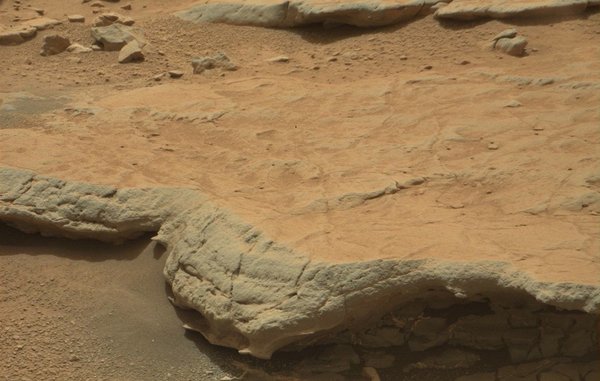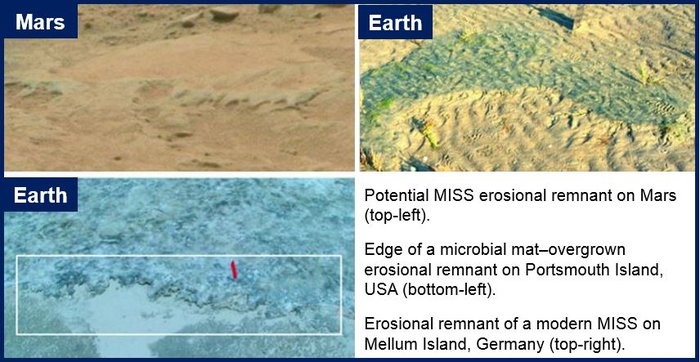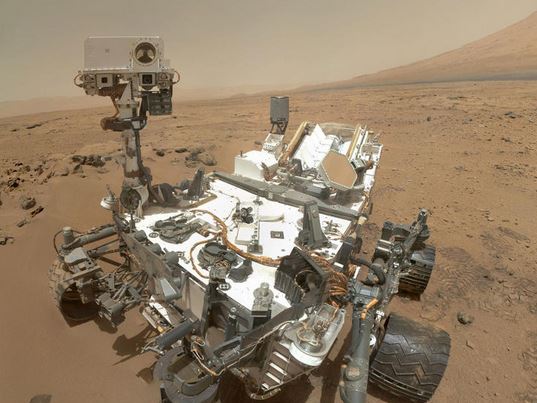NASA scientists have been studying images taken by the NASA rover Curiosity that appear to show there may well have been life on Mars in the past. The pictures show fascinating similarities between ancient sedimentary rocks on Mars and rocks shaped by microbes on Earth.
The images were taken when Curiosity was travelling through the Gillespie Lake outcrop in Yellowknife Bay, a dry lakebed that billions of years ago underwent seasonal flooding. At that time, Mars had a much warmer a wetter climate.
On our planet, carpet-like colonies of microbes trap and rearrange sediments in shallow waters such as coastal areas and lakes, forming distinctive features that eventually fossilize.
These structures, known as MISS (microbially-induced sedimentary structures), are commonly found worldwide in shallow water settings and in ancient rocks spanning Earth’s history.
Geobiologist Nora Noffke, who works at Old Dominion University, Virginia, has spent the last two decades studying these microbial structures. In 2014, Associate Professor Noffke reported that she and her team had discovered MISS aged 3.48 billion years in the Western Australia’s Dresser Formation, making them the earliest signs of life on Earth.
Mars: a rock bed at the Gillespie Lake outcrop displays potential signs of ancient microbial sedimentary structures. Photo: NASA.
In a report published in the journal Astrobiology online in December 2014, Noffke lists the striking morphological similarities between Martian sedimentary structures in the Gillespie Lake outcrop, which is up to 3.7 billion years old, and Earth’s microbial structures.
The distinctive shapes include domes, roll-ups, pockets, chips, cracks and erosional remnants, which on our planet can extend from a few centimeters to several kilometers.
Not definite proof, but…
While Noffke’s account makes a tantalizing case for likely signs of ancient life on the red planet, it is not definite proof that the structures were formed by biology (life). To get proper confirmation, rock samples would need to be transported back to Earth so that scientists could conduct further microscopic analyses, a mission that won’t happen in the near future.
Noffke said:
“All I can say is, here’s my hypothesis and here’s all the evidence that I have, although I do think that this evidence is a lot.”
Penelope Boston, a geomicrobiologist at the New Mexico Institute of Mining and Technology, said:
“The fact that she pointed out these structures is a great contribution to the field. Along with the recent reports of methane and organics on Mars, her findings add an intriguing piece to the puzzle of a possible history for life on our neighboring planet.”
Photo for Mars: NASA; Earth: Nora Noffke.
Chris McKay, a planetary scientist at NASA’s Ames Research Center and an associate editor of the journal Astrobiology, said:
“I’ve seen many papers that say ‘Look, here’s a pile of dirt on Mars, and here’s a pile of dirt on Earth. And because they look the same, the same mechanism must have made each pile on the two planets.’”
“That’s an easy argument to make, and it’s typically not very convincing. However, Noffke’s paper is the most carefully done analysis of the sort that I’ve seen, which is why it’s the first of its kind published in Astrobiology.”
Noffke recalls:
“In one image, I saw something that looked very familiar. So I took a closer look, meaning I spent several weeks investigating certain images centimeter by centimeter, drawing sketches, and comparing them to data from terrestrial structures. And I’ve worked on these for 20 years, so I knew what to look for.”
She compared the rover images to pictures taken at several sites on Earth, including Portsmouth Island, USA; Mellum Island, Germany; and Carbla Point, Western Australia. They were also compared to the older fossils of the Dresser Formation in Western Australia; the Pongola Supergroup in Africa, and Bajar Alouane in Tunisia.
Noffke said the images showed striking morphological similarities between the Martian sedimentary structures and those on Earth.
The distribution of patterns of the terrestrial microbial structures vary, depending on where they are found. The patterns seen in the Gillespie Lake outcrop (on Mars) are consistent with the microbial structures found in similar environments on Earth.
Chronological clues add to likelihood of life on Mars
Noffke also found that the distribution pattern in Martian rocks correspond with terrestrial microbial structures that have changed over time. Taken together, these clues make her argument more compelling, and not just a case of pointing out some similarities in shape.
Curiosity rover self-portrait. Photo: NASA.
Noffke said:
“But if the Martian structures aren’t of biological origin,” Noffke says, “then the similarities in morphology, but also in distribution patterns with regards to MISS on Earth would be an extraordinary coincidence.”
“At this point, all I’d like to do is point out these similarities. Further evidence must be provided to verify this hypothesis.”
Source: “Potential Signs of Ancient Life in Mars Rover Photos,” by Johnny Bontemps. ASTROBIOLOGY MAGAZINE. Jan 5, 2015.



